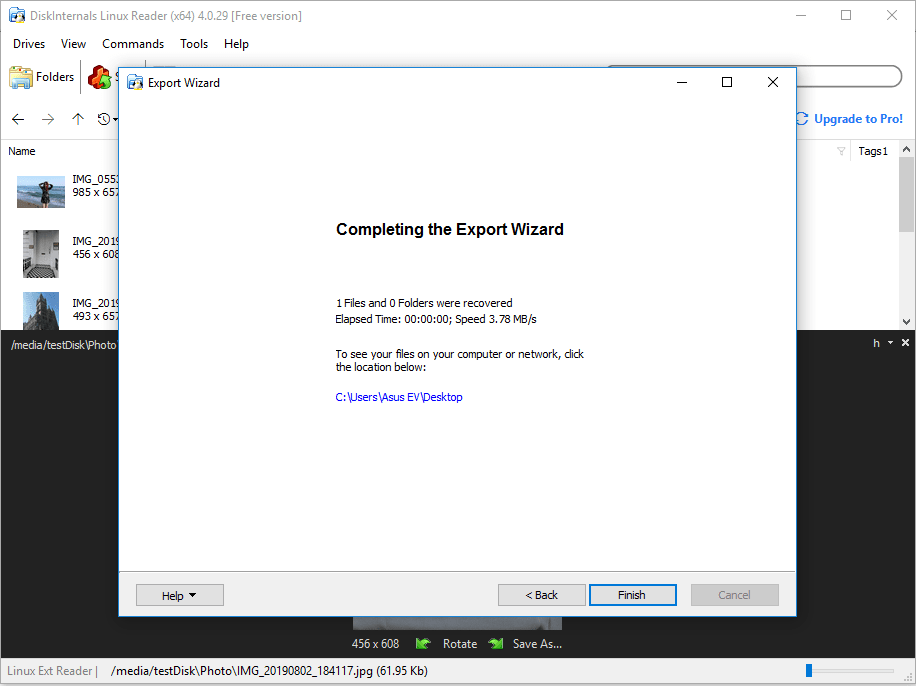
- LINUX DRIVE READER HOW TO
- LINUX DRIVE READER INSTALL
- LINUX DRIVE READER FULL
- LINUX DRIVE READER WINDOWS 10
- LINUX DRIVE READER PLUS
LINUX DRIVE READER WINDOWS 10
Up till now, the formatted partition should be recovered, and then you can read Linux partition Windows 10 and access its files.Īlso, you can try the other three utilities to access Ext4 from Windows 10. Click on Apply button to recover the formatted partition on the hard disk. Wait for some time until the scanning completes and click on the Finish button. Step 4. Make sure that you check all partitions including existing partitions and deleted/formatted partitions. Step 3. Select a scanning method to scan the disk and click Next to continue.
LINUX DRIVE READER FULL
Here we take Full Disk for example and click on Next to go on. There are 3 ranges to scan the disk including Full Disk, Unallocated Space, and Specified Range. Step 2. Choose a scanning range based on your needs. Step 1. In the main interface, select the partition that you just formatted to NTFS and click on Partition Recovery from the top toolbar.
LINUX DRIVE READER INSTALL
You need to install a professional edition or a more advanced edition to recover the lost partition. Tip: MiniTool Partition Wizard Free Edition doesn’t support data recovery. Please continue with the following steps. Here MiniTool Partition Wizard is capable of restoring Ext4 partition data.
LINUX DRIVE READER HOW TO
Another question is how to regain data from the formatted partition. Now, you should make the Ext4 accessible on Windows 10. Part 2: Restore Data from the Ext4 Partition Click on Apply button to execute the operation. In the pop-up window, select NTFS from the drop-down menu and click on OK to continue. Launch the MiniTool Partition Wizard to enter its main interface, and then right-click the Ext4 partition from the disk map and select Format. Although formatting will delete the data on the hard drive, MiniTool can help you restore the Ext4 partition data so that you can access Linux files from Windows 10.įollow the steps below to format the Ext4 partition to NTFS or other file systems that are supported by Windows 10. In order to access Ext4 from Windows smoothly, you can make it accessible by formatting it to NTFS. With this powerful software, you can format a hard drive, convert NTFS to FAT, convert MBR to GPT, recover lost data, migrate OS to SSD/HD, rebuild MBR, and so forth.

MiniTool Partition Wizard is an all-in-one partition manager that supports many file systems including FAT16/32, NTFS, exFAT, and Ext2/3/4, Linux Swap. Use Ext4 Partition Manager - MiniTool Partition Wizard Here we summarize top 4 Ext4 partition readers on Windows. Since Windows 10 doesn’t offer any direct methods to access Ext4, you need to utilize some professional tools to access Linux files from Windows. How to Access Linux Files from Windows 10 What can I do if I have to read Linux drive on Windows? Please keep reading the following part. Obviously, you can’t access Ubuntu files from Windows directly. When right-clicking the Ext4 partition, you will find the Open and other function menus become greyed out. However, the Ext4 file system is not supported by Windows. That is to say, you have to read Ext4 from Windows if you want to access Linux files. Can I access Linux files from Windows 10? As discussed above, the most common Linux file system is Ext4.
LINUX DRIVE READER PLUS
There are a lot of users who have Windows 10 plus Linux dual boot or a hard drive formatted with Ext4. Top recommendation: How to Install Linux (Ubuntu) on Windows 10 Can I Access Linux Files from Windows 10 It’s reported that the Ext4 can support storing a file up to 16TB and creating a partition up to 1EB. This is because the Ext4 provides more flexibility for storing large files than other extended file systems. The common Linux Files Systems are Ext2, Ext3, and Ext4.Īt present, Ext4 has become the default file system for most Linux distributions including Debian and Ubuntu. In order to access Linux files from Windows successfully, the first thing you should figure out is what file system is supported by Linux. After analyzing lots of user reports on forums, we conclude the following questions that are frequently talked about. If you have a Linux distribution alongside a Windows system on the laptop or desktop, you may need to access Linux files from Windows 10. How to Access Linux Files from Windows 10.

Can I Access Linux Files from Windows 10.


 0 kommentar(er)
0 kommentar(er)
